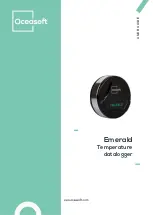
Section 8. Operation
423
8.1.2.7.3 Voltage Measurement Quality
Read More
Consult the following technical papers at
www.campbellsci.com/app-notes
for in-depth treatments of several topics
addressing voltage measurement quality:
• Preventing and Attacking Measurement Noise Problems
• Benefits of Input Reversal and Excitation Reversal for Voltage
Measurements
• Voltage Measurement Accuracy, Self- Calibration, and Ratiometric
Measurements
• Estimating Measurement Accuracy for Ratiometric Measurement
Instructions.
The following topics discuss methods of generally improving voltage
measurements. Related information for special case voltage measurements
(
thermocouples
(p. 405),
current loops
(p. 415),
resistance
(p. 406),
and
strain
(p. 413))
is
located in sections for those measurements.
Single-Ended or Differential?
Deciding whether a differential or single-ended measurement is appropriate is
usually, by far, the most important consideration when addressing voltage
measurement quality. The decision requires trade-offs of accuracy and precision,
noise cancelation, measurement speed, available measurement hardware, and
fiscal constraints.
In broad terms, analog voltage is best measured differentially because these
measurements include noise reduction features, listed below, that are not included
in single-ended measurements.
•
Passive Noise Rejection
o
No voltage reference offset
o
Common-mode noise rejection, which filters capacitively coupled
noise
•
Active Noise Rejection
o
Input reversal
—
Review
Input and Excitation Reversal
(p. 400)
for details
—
Increases by twice the input reversal signal f notch
Reasons for using single-ended measurements, however, include:
•
Not enough differential terminals available. Differential measurements
use twice as many
U
terminals as do single-ended measurements.
•
Sensor is not designed for differential measurements. Many Campbell
Scientific sensors are not designed for differential measurement, but the
draw backs of a single-ended measurement are usually mitigated by large
programmed excitation and/or sensor output voltages.
Содержание CR6 Series
Страница 2: ......
Страница 4: ......
Страница 6: ......
Страница 32: ......
Страница 36: ......
Страница 38: ......
Страница 76: ...Section 5 Overview 76 FIGURE 20 Half Bridge Wiring Example Wind Vane Potentiometer ...
Страница 80: ...Section 5 Overview 80 FIGURE 23 Pulse Input Wiring Example Anemometer ...
Страница 136: ......
Страница 251: ...Section 7 Installation 251 FIGURE 46 Running Average Frequency Response FIGURE 47 Running Average Signal Attenuation ...
Страница 454: ...Section 8 Operation 454 FIGURE 104 Narrow Sweep High Noise ...
Страница 459: ...Section 8 Operation 459 FIGURE 106 Vibrating Wire Sensor Calibration Report ...
Страница 535: ...Section 8 Operation 535 8 11 2 Data Display FIGURE 121 CR1000KD Displaying Data ...
Страница 537: ...Section 8 Operation 537 FIGURE 123 CR1000KD Real Time Custom ...
Страница 538: ...Section 8 Operation 538 8 11 2 3 Final Storage Data FIGURE 124 CR1000KD Final Storage Data ...
Страница 539: ...Section 8 Operation 539 8 11 3 Run Stop Program FIGURE 125 CR1000KD Run Stop Program ...
Страница 541: ...Section 8 Operation 541 FIGURE 127 CR1000KD File Edit ...
Страница 542: ...Section 8 Operation 542 8 11 5 PCCard Memory Card Management FIGURE 128 CR1000KD PCCard Memory Card Management ...
Страница 546: ......
Страница 549: ...Section 9 Maintenance Details 549 FIGURE 133 Separate Back Shell from Module FIGURE 134 Disconnect Battery Connector ...
Страница 552: ......
Страница 610: ...Section 11 Glossary 610 FIGURE 137 Relationships of Accuracy Precision and Resolution ...
Страница 612: ......
Страница 648: ......
Страница 650: ......
Страница 688: ......
Страница 689: ......
















































